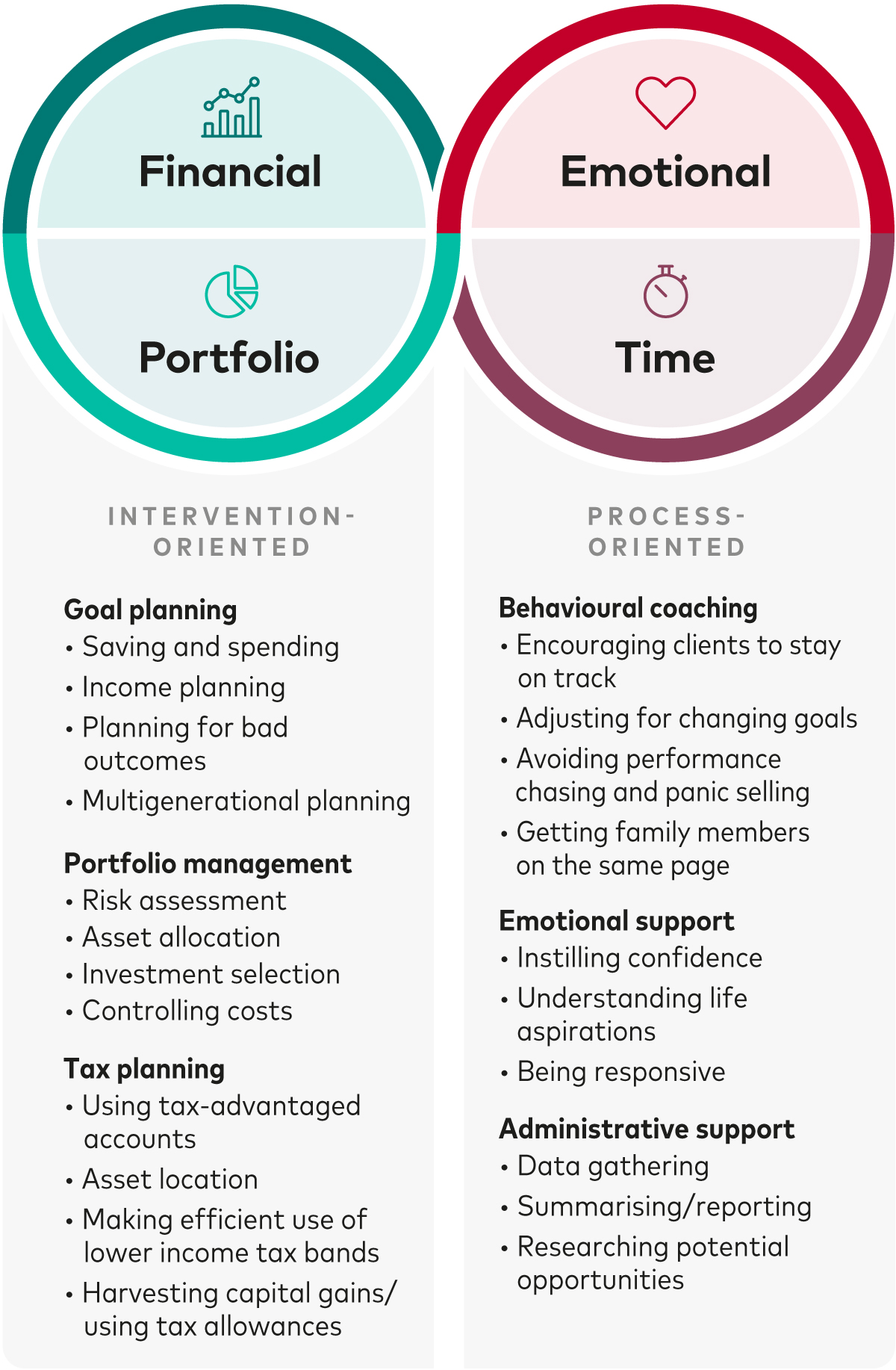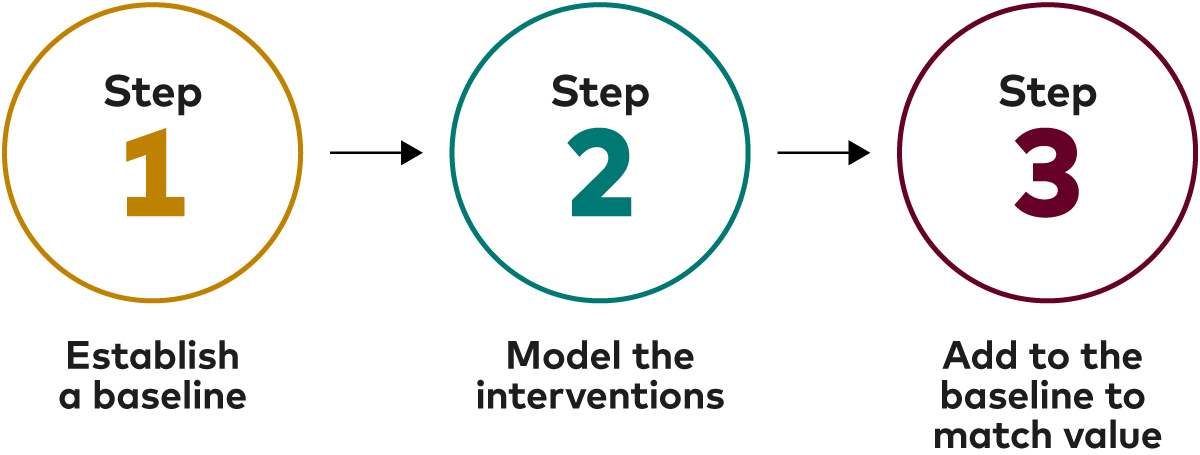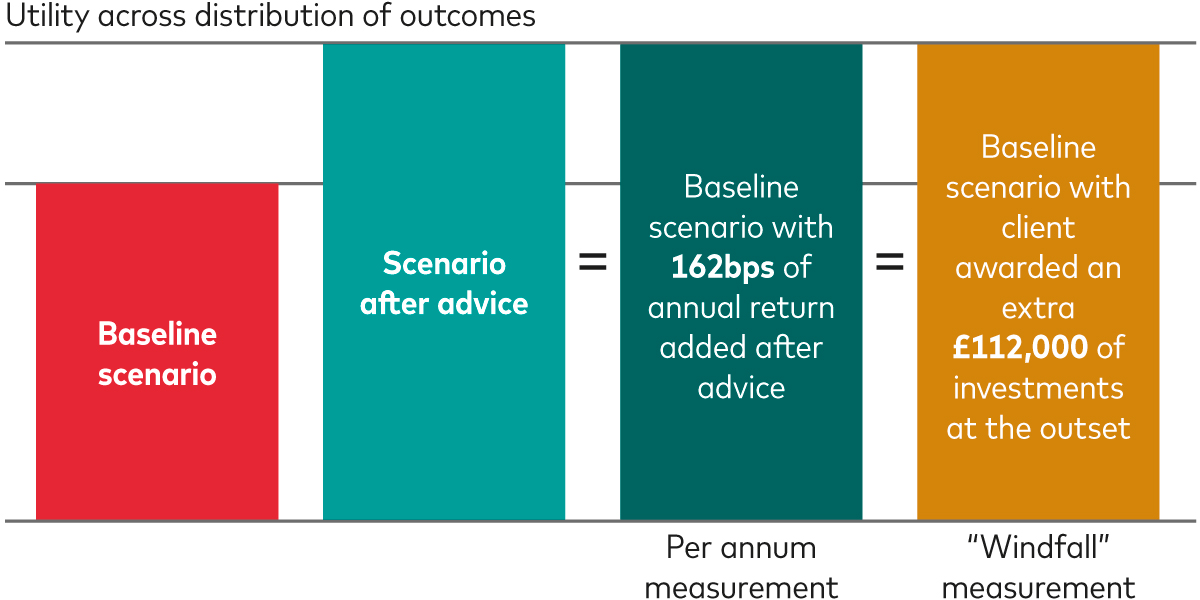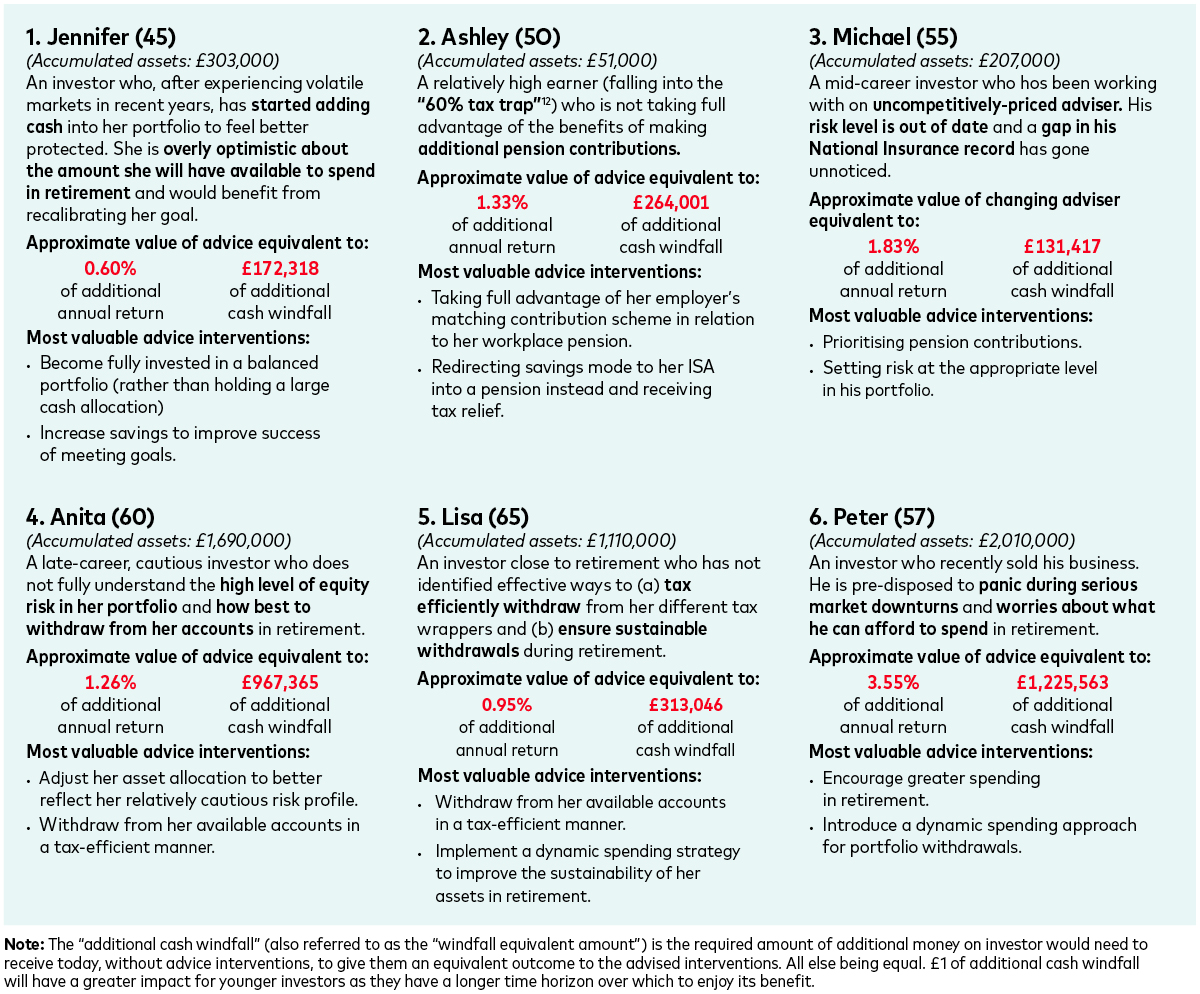Executive Summary
Personalised financial advice can deliver significant benefits. Accurately quantifying those benefits, though, has historically proved a challenge for advisers and investors.
In this latest study, we build on our Adviser’s Alpha research by exploring the value of financial advice to individual investors based in the UK.
We begin by expanding our previous framework to help advisers identify the sources of advice value with clients, followed by a process for measuring the value of specific advice interventions at the individual level.
As part of this process, we introduce our new model, the Vanguard Financial Advice Model (VFAM). Originally developed for use in the US, VFAM has been re-calibrated for the UK investing landscape. VFAM enables us to quantify the incremental value that advice can provide to an individual investor’s financial plan relative to their current strategy.
To demonstrate the new model and process, we present six case studies that illustrate how advisers can quantify the value their services generate for individual clients based in the UK, using a range of typical advice interventions.
Across the case studies, we see the total value of advice, net of fees, ranging from 60 basis points (bps) to 355 bps annually per individual. The actual values of these interventions to an investor could be well above or below this range based on their personal circumstances and the specific advice interventions considered.
Introduction
Understanding the monetary value of advice interventions at the individual level can help advisers more easily articulate their value to existing and prospective clients.
By putting a number on the value of advice, financial advisers can surface and focus on the highest-value advice interventions – which can help demonstrate value to clients and, in turn, retain and attract more business. Unadvised investors can learn whether financial advice is right for them. Advised investors can benefit from knowing how advice adds value beyond the fees they pay their advisers. Finally, as the number of hybrid and robo/digital advisory services grows, the financial advice industry can get a better understanding of the different cost-to-serve models according to the value of the services they provide.
Sources of value
Financial advice can provide value in a multitude of ways, whether delivered by human advisers, digital platforms or investment product solutions.
Some examples of services include:
- Being a source of professional expertise and judgment for investors when they need it.
- Helping investors uncover their goals and setting up roadmaps for meeting those goals.
- Managing portfolios to maximise potential returns while controlling for risk and minimising taxes.
- Preparing investors to deal with the possibility of unpredictable outcomes that may have low probability but catastrophic effects, such as early death.
- Keeping on top of an investor’s changing life needs and making sure that plans stay on course.
- Saving investors time by performing resource-intensive tasks on their behalf.
- Offering emotional support and guidance to help investors stay motivated and provide peace of mind.
The value of advice framework
Previously, Vanguard proposed a three-part framework for understanding the types of value that advisers can provide investors:
Financial value. Ultimately, investment returns are only important in the service of helping investors achieve specific financial objectives. Advisers can engage in a myriad of financial planning strategies to ensure that investors are prepared to meet the financial challenges that they and their families may face.
Portfolio value. This type of value comes from building a well-diversified portfolio that generates better after-tax risk-adjusted returns net of all fees, suitably matched to the client’s risk tolerance.
Emotional value. This type of value comes from helping investors achieve financial well-being, or peace of mind.
For this discussion, we add a fourth type of value to this model:
Time value. This type of value comes from the simple fact that advice providers perform tasks that individual investors might otherwise not have the time, willingness or ability to perform on their own.

Financial and portfolio value are most often delivered by the specific interventions that advice providers recommend for each investor. Emotional and time value are most often delivered by processes by which the advice provider produces, explains and implements those interventions, and ensures that they are followed through. Figure 1 shows how specific types of advice interventions and activities map to our larger value framework.
To maximise their value-add, advisers can match each client with the interventions that are most likely to deliver the greatest amount of value in the most efficient way possible.
Advice as an ongoing process
For every client, advisers should consider each of the advice opportunities in Figure 1. In many ways, the most valuable task an adviser performs is choosing which advice interventions to bring to each investor for implementation.
The process of advice adds ongoing value when advisers engage in activities like these:
- Following up to make sure that clients are saving as much as they need to.
- Showing clients how their plans give them flexibility to spend and enjoy life.
- Educating and reassuring clients in times of market euphoria or turmoil so that they stay on track.
- Representing their financial interests in conversations with other professionals like insurance brokers, tax advisers or solicitors.
- Recognising opportunities to take advantage of tax-efficient strategies.
- Encouraging clients to stay invested and avoid large cash holdings.
- Coaching clients, when needed, on the elements of financial wellness1.
It is an adviser’s responsibility to monitor clients and their portfolios to know when any changes are needed. By effectively engaging investors and providing expertise though activities like these, the adviser earns the client’s trust—one of the primary drivers of a successful long-term advice relationship.
The importance of personalisation
Investors who do not feel their advice provider understands their needs are unlikely to be confident in the adviser’s ability to deliver the results they desire. Understanding the aspirations of the investor and crafting a tailored and personal financial plan is key for delivering value. We believe the more personal an advice solution is, the more value it can deliver, at least before fees are considered.
Previous Vanguard research explored investors’ preferences for human versus digital advice services, and found that advised clients prefer human advisers for delivering emotional outcomes and financial planning services. Services requiring a high level of personalisation, such as understanding clients’ needs and financial goals, were highly preferred to be delivered by human advisers. On the other hand, technology platforms received higher scores for delivering portfolio management services such as diversification and tax-efficient planning. Overall, investors see a need for both human and digital services working in tandem.
Staying the course
Putting together an initial plan is only the first step in an advice relationship: clients will only reach their goals if they stick to the plan.
Most investors are aware of the importance of maintaining a disciplined approach, but they may find it difficult to follow through. Advisers can add significant value by acting as a behavioural coach and encourage clients to stay on track – especially during periods of market turbulence.
Measuring the value of advice
It is difficult to put a monetary number on the emotional and time value components of advice, given the subjective nature of those elements.
As a result, our process concentrates on how to quantify the financial and portfolio values of advice for an individual investor.
To do this, we’ve developed a three-step process laid out in Figure 2.

Step 1: Establish a baseline model.
- What will an investor do in the absence of the advice interventions we want to measure?
- What is the range of potential outcomes the investor will face if they follow that baseline strategy?
Step 2: Add the advice interventions we want to value.
- What changes should the investor make?
- How does the range of potential outcomes improve as a result?
Step 3: Compare the new outcomes with the baseline model.
- Work out the additional level of annual return (or initial monetary amount) that would need to be added to the baseline to match the value of the advised interventions.
For example, let’s assume that a client adopts a tax-planning strategy devised by their financial adviser. This allows the client to keep a larger portion of after-tax investment returns across a wide range of market scenarios. We can measure the value added from this intervention in different ways:
- What additional return would we need to add to the baseline for the baseline set of outcomes to be as good as the tax-efficient strategy?
- What additional amount of starting wealth would we need to add for the baseline set of outcomes to be as good as the tax-efficient strategy?
Figure 3 illustrates this idea. In this case, we measure the value added to the client in two ways: first, as an annual additional return of 1.62% (dark green bar); and, second, as an initial “windfall-equivalent” measurement of £112,000 (gold bar). This is the additional lump-sum amount that would need to be added to an investor’s taxable account today to obtain the same long-term financial benefit as the tax-efficient strategy.
Figure 3: Ways to measure value using VFAM

Measuring advice value with VFAM
To facilitate the advice valuation process, Vanguard has developed VFAM. While the model is not available to advisers, in this section we offer an insight on how the model works. We then provide six case study examples to demonstrate how advisers can quantify the value of relevant advice interventions for individual clients.
Figure 4: Elements of the Vanguard Financial Advice Model

Figure 4 illustrates the four key elements of VFAM that we believe contribute to an accurate estimate of advice value.
Cash flow simulation
In addition to incorporating the intricacies of the UK tax system, VFAM also integrates a variety of asset allocation and rebalancing strategies as well as fee structures. VFAM also accounts for a range of investor behaviour patterns – for example, the risk that an investor may choose to move to an all-cash portfolio if they experience a sudden or significant loss.
Asset class return simulations
VFAM uses the Vanguard Capital Markets Model® (VCMM) to account for potential differences in market conditions and inflation environments. By projecting across 10,000 different market scenarios, VFAM evaluates a wide range of possible outcomes for an investor’s current portfolio approach versus its advised alternative.
Life expectancy variability
Differences in life expectancy are a source of considerable uncertainty in long-term financial projections. Rather than making fixed assumptions about longevity, VFAM takes an age-weighted approach to calculate potential financial outcomes.
Utility-based scoring
This variable assesses the additional life satisfaction, or utility, that wealth can provide for an individual investor, and the trade-offs between current and future spending. For example, it considers the different levels of utility for spending and retaining wealth to pass on through inheritance.
The benefits of the VFAM approach
We believe our advice valuation process improves on traditional approaches in three main ways:
Personalisation
Our approach assesses value at the individual investor level, explicitly accounting for differences in tax brackets and other attributes. By quantifying the value of a specific set of advice interventions, it is possible to prioritise higher-value interventions for each client.
Distributional outcomes
Our method values each possible outcome and weighs them appropriately. While most advice models simply project to a given age, VFAM also accounts for life-expectancy variability.
Multi-strategy effects
Each potential advice intervention can provide value in isolation, but by measuring a set of interventions together, we can see how the total value is not just the sum of its parts. In some cases, advice interactions may interact to produce superior outcomes than when applied separately from each other.
The true value of advice: Case studies
The advisory activities that are most valuable and effective will vary greatly from person to person depending on a range of factors, including their personal characteristics, life stage and market conditions.
To illustrate the flexibility of our measurement approach, we provide six individual investor case studies of typical clients based in the UK at different life stages, offering different opportunities for an adviser to add value. The client case studies cover a broad range of financial planning and portfolio construction issues faced by UK investors.
Figure 5. provides a summary of the case studies. More detailed information on all the case studies and their value calculations are provided in the next unit of this module.
Figure 5: Summary of case studies

Conclusion
Financial advisers provide value in many ways, and the value of helping investors reach their goals is far higher than many imagine. By making that value tangible, advisers can improve client outcomes, attract new clients and retain existing ones.
The key to providing value in any situation is to first understand the goals and plans of each client, then identify the right set of advice interventions to match their needs. Measuring this value is a key task in helping advisers discover the most valuable advice recommendations, and in communicating to clients the ongoing value of sticking to their plan.
As life progresses and aspirations and market conditions change, advisers should monitor clients’ changing needs and continue to find opportunities to provide value.
1 We define financial wellness as the objective financial situation of a person, household or family. It is the ability to meet current and near-term financial obligations and to be on track to meet future goals (see Vanguard’s Guide to financial wellness: Costa and Felton 2022)., including budgeting, emergency savings and debt repayment.
Complete the module
Unit 2: The emotional value of advice
Reading time: 11 minutes
Here, we draw on Vanguard’s more than 20 years of research on the emotional value of advice and explore how financial advisers add value.
 Read the article
Read the articleVideo 1: The value of giving investors personalised advice
Watching time: 2 minutes
Why understanding the value of personalised advice can help retain and attract more clients.
 Watch the video
Watch the videoReady to test your knowledge?
If you have completed all content in the module, you are ready to take the quiz and collect your CPD
 Take the quiz
Take the quiz
Other Vanguard 365 pillars
Practice management
Tailored content to help you build your practice, market your services effectively and cultivate a thriving professional network.
Financial planning
CPD content structured to give you access to useful tools, guides and multimedia resources covering diverse topics from risk profiling to retirement planning.
Investment knowledge
CPD content formulated for you to explore in-depth insights on investment principles, portfolio construction and comprehensive product education to expand your technical knowledge.
Investment risk information
The value of investments, and the income from them, may fall or rise and investors may get back less than they invested.
Important information
This article is designed for use by, and is directed only at persons resident in the UK.
The information contained in this article is not to be regarded as an offer to buy or sell or the solicitation of any offer to buy or sell securities in any jurisdiction where such an offer or solicitation is against the law, or to anyone to whom it is unlawful to make such an offer or solicitation, or if the person making the offer or solicitation is not qualified to do so. The information in this document does not constitute legal, tax, or investment advice. You must not, therefore, rely on the content of this article when making any investment decisions.
The information contained in this article is for educational purposes only and is not a recommendation or solicitation to buy or sell investments.
© 2025 Vanguard Asset Management, Limited. All rights reserved.
Vanguard Asset Management, Limited is authorised and regulated in the UK by the Financial Conduct Authority.